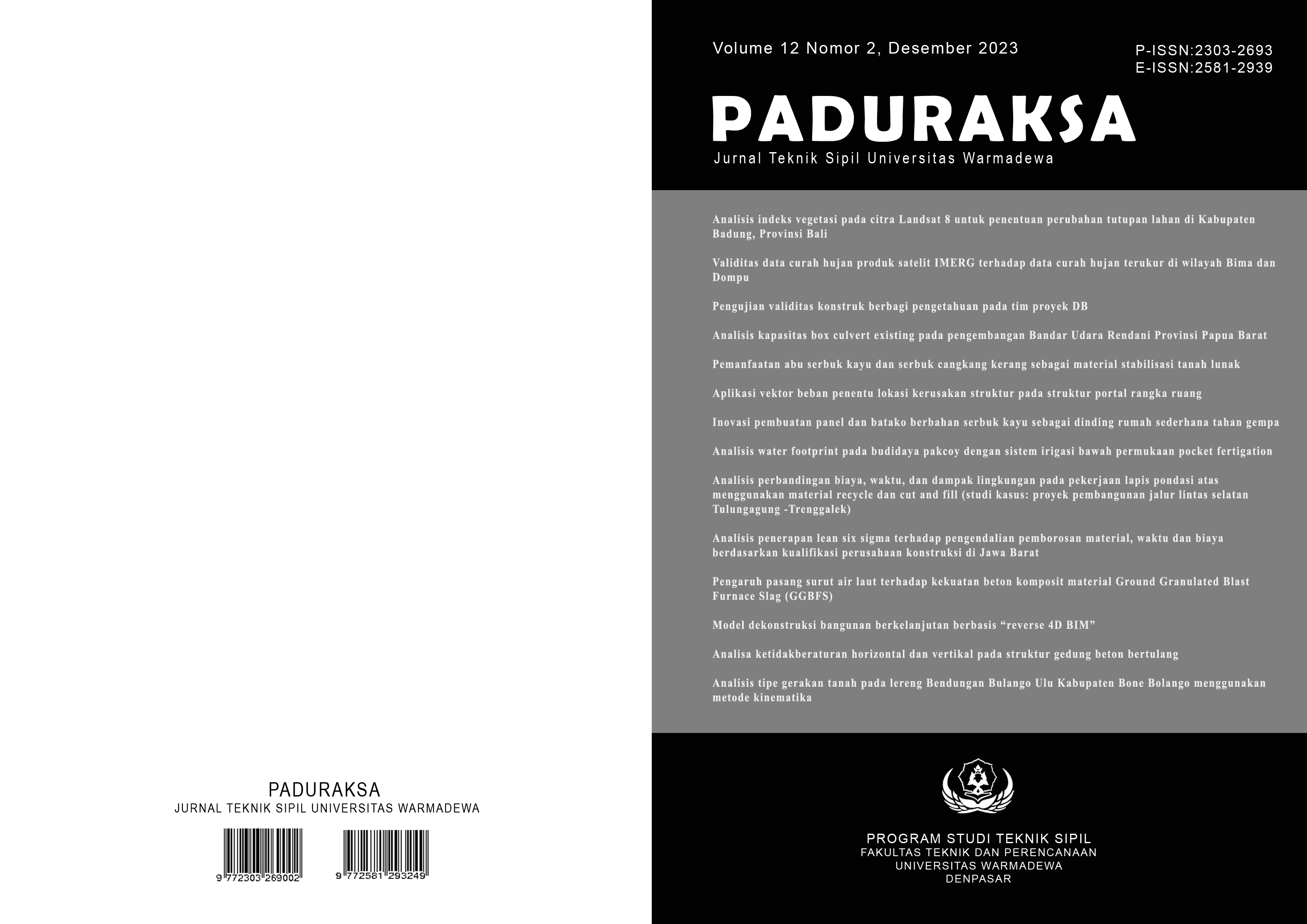Analisa ketidakberaturan horizontal dan vertikal pada struktur gedung beton bertulang
Abstract
The behavior of regular and irregular building structures in resisting earthquake loads will certainly be different, so structural modeling must be done in such a way as to form a safe structure. The building in this study is L-shaped with an area of 2079.52 m2 with 6 floors and 28 m of total height. Earthquake load modeling in this study uses the equivalent static analysis method and design spectrum response about SNI concrete 2847-2019 and SNI earthquake 1726-2019. This study aims to investigate the behavior of multilevel reinforced concrete structures that experience horizontal and vertical irregularities due to earthquake loads as seen from the displacement and drift ratios that occurs is based on the results of numerical analysis. Based on the results of research on the geometry of the structure with vertical irregularities, it shows that the structure does not have Type 1a, Type 1b, Type 2, Type 3, Type 4, Type 5a and Type 5b irregularities. Thus the structure can be planned without considering the requirements to satisfy vertical irregularities. The geometry of the structure with horizontal irregularities shows that the structure has no irregularities in Type 1a, Type 1b, Type 3, Type 4 and Type 5. Meanwhile in Type 2 the structure is stated to have irregular inside angles, so the design force of the diaphragm on the structure must be increased by 25% at the planning stage.
References
Ahmed, M. M., Raheem, S. E. A., & Shafy, A. G. A. (2016). Irregularity Effects on The Seismic Performance Of L-Shaped Multi-Story Buildings. JES, Assiut University, Faculty of Engineering, 44(5). 513 – 536. DOI: 10.21608/jesaun.2016.111440
Alam, H., Kusuma, B. S., & Prayogi, M. A. (2020). Penggunaan Sensor Vibration Sebagai Antisipasi Gempa Bumi. Journal of Electrical Technology, 5(2). 43-53.
Alavi, A. and Rao, P. S. (2013). Effect of Plan Irregular RC Buildings in High Seismic Zone. Australian Journal of Basic and Applied Sciences, 7(13). 1-6.
Anonim. (2019). SNI 2847-2019 Persyaratan Beton Struktural untuk Bangunan Gedung. Jakarta: Badan Standarisasi Nasional.
Anonim. (2019). SNI 1726-2019 Tata Cara Perencanaan Ketahanan Gempa untuk Struktur Bangunan Gedung dan Non Gedung. Jakarta: Badan Standarisasi Nasional.
Anonim. (2020). SNI 1727-2020 Beban Desain Minimum untuk Bangunan Gedung dan Struktur Lain. Jakarta: Badan Standarisasi Nasional.
Banginwar R. S., Vyawahare, P. M, & Modani. (2012). Effect of Plans Configurations on the Seismic Behaviour of the Structure by Response Spectrum Method. International Journal of Engineering Research and Applications (IJERA), 2(3). 1439-1443.
Divyashree, M., Bhavyashree, B. N., Siddappa, G., (2014). Comparison of Bracings and Shear Walls as Seismic Strengthening Methods to Buildings with Plan Irregularities. International Journal of Research in Engineering and Technology, 3(18). 205-210.
Elnashai A. S., & Sarno, L. D. (2008). Fundamentals of Earthquake Engineering. 1st edition. Wiley New York.
Ghimire, K., & Chaulagain, H. (2021). Influence of Structural Irregularities on Seismic Performance of RC Frame Buildings. Journal of Engineering Issues and Solutions, 1(1). 70-87. DOI:10.3126/joeis.v1i1.36820
Khanal, B., & Chaulagain, H. (2020). Seismic Elastic Performance of L-Shaped Building Frames Through Plan Irregularities. Structures, 27, 22-36. https://doi.org/10.1016/j.istruc.2020.05.017
Naveen E, S., Abraham, N. M., & S D, Kumalasari, A. (2019). Analysis of Irregular Structures under Earthquake Loads. Procedia Structural Integrity, 14, 806–819. DOI: 10.1016/j.prostr.2019.07.059
Prayuda, H., Zega, B. C., & Priyosulistyo, H. (2017). Prediction of Allowable Lateral Ground Acceleration (In-Plane Direction) of Confined Masonry Walls Using Ambient Vibration (Microtremor) Analysis. Procedia Engineering, 171. 1194-1203. https://doi.org/10.1016/j.proeng.2017.01.487
Prayuda, H., Wilasamba, O., Saleh, F., dan Maulana, T. I. (2022). Evaluasi Perilaku Seismik Akibat Ketidakberaturan Vertikal pada Bangunan Beton Bertulang Bertingkat Tinggi. Media Komunikasi Teknik Sipil, 28(2), 178-191. DOI:10.14710/mkts.v28i2.41765
Rajalakshmi, K., Harinarayanan, J. S., Varughese, A., & Girija, K. (2015). Study of Torsion Effects on Building Structures Having Mass and Stiffness Irregularities. International Journal of Engineering Research and Technology, ESRSA Publications, 4(6): 1318-1325. DOI: http://dx.doi.org/10.17577/IJERTV4IS061059
Rau, F., Wibawa, I. M. S., Tubuh, I. K. D. K., & Nada, I. M. (2023). Analisis Kinerja Struktur Gedung dengan Ketidakberaturan Horizontal. Jurnal Ilmiah Teknik Unmas, 3(1), 26-31.
Sakale, R., Arora, R., & Chouhan, J. (2014). Seismic Behavior of Buildings Having Horizontal Irregularities. International Journal of Structural and Civil Engineering Research, 3(4). 77-84. DOI: 10.18178/ijscer
Simamora, J., Wibowo, L. S. B., Purwanto, D., & Ray, N. (2020). Analisis Perpindahan Lateral Struktur Beton Bertulang pada Bangunan Bertingkat Beraturan dan Ketidak Beraturan Horizontal. Ge-STRAM: Jurnal Perencanaan dan Rekayasa Sipil, 3(1). 19-23. DOI:10.25139/jprs.v3i1.2436
Soltani, M., Gholami, H., Norouzi, H., Dastgerdi, H. R. S., & Askari, K. O. A. (2018). The Influence of L-Shaped Structures on their Behavior against Earthquakes. International Journal of Constructive Research in Civil Engineering (IJCRCE), 4(4). 1-8. DOI: http://dx.doi.org/10.20431/2454-8693.0404001
Syafara, A. A. (2023). Analisis Respons Ketidakberaturan Horizontal dan Vertikal Pada Gedung Perkuliahan di Yogyakarta dengan Menggunakan SNI 1726-2019. Universitas Islam Indonesia. Yogyakarta.
Authors who publish with this journal agree to the following terms:
- Authors retain copyright and grant the journal right of first publication with the work simultaneously licensed under a Creative Commons Attribution License that allows others to share the work with an acknowledgement of the work's authorship and initial publication in this journal.
- Authors are able to enter into separate, additional contractual arrangements for the non-exclusive distribution of the journal's published version of the work (e.g., post it to an institutional repository or publish it in a book), with an acknowledgement of its initial publication in this journal.
- Authors are permitted and encouraged to post their work online (e.g., in institutional repositories or on their website) prior to and during the submission process, as it can lead to productive exchanges, as well as earlier and greater citation of published work (See The Effect of Open Access).
 Abstract viewed = 253 times
Abstract viewed = 253 times
 PDF downloaded = 946 times
PDF downloaded = 946 times










